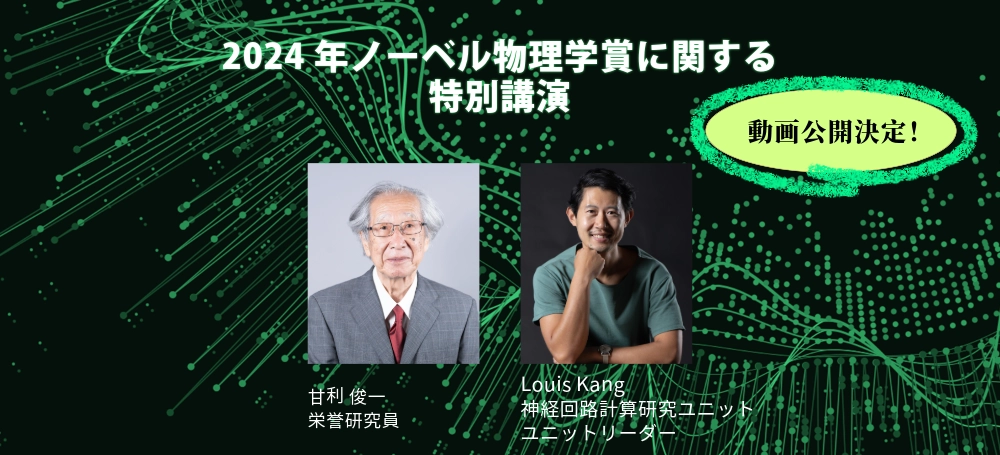
2024年ノーベル物理学賞に関する特別講演 録画公開
2025年4月24日
2024年のノーベル賞は、AI関連の受賞が相次ぎ大きな反響を呼びました。物理学賞では、人工ニューラルネットワークによる機械学習を可能にする基礎的発見と発明に関する業績で ジョン・J・ホップフィールド 博士とジェフリー・E・ヒントン 博士が受賞しました。その業績の源流には、甘利 俊一 栄誉研究員・元脳科学総合研究センター長をはじめとした、日本における数理脳科学者たちの功績もあります。 本動画は2024年12月に理研脳神経科学研究センター(CBS)が開催した、ノーベル物理学賞解説セミナーを再編集したものです。
ぜひご覧ください。
甘利俊一「人工知能と数理脳科学」-2024年ノーベル物理学賞に関する特別講演
「人工知能と数理脳科学」 私たちは二つの知能システムを持つに至った。人工知能と自然知能(脳)である。 二つの歴史的な発展を述べるとともに、相互の交流を考える。1960、70年代、欧米のニューロモデル研究は冬の時代を迎えたが、日本では神経生理学と数理科学とが交流し、この分野の先進国であった。これがその後発展につながり、今回のノーベル賞の受賞につながっている。 神経回路モデルについて簡単に解説するとともに、人工知能が脳と心の研究に、また社会や文明に及ぼす大きな影響について考えてみたい。
The 2024 Nobel Prizes have been awarded for a series of AI-related achievements that have caused a great sensation. In Physics, John J. Hopfield and Geoffrey E. Hinton were recognized for their fundamental discoveries and inventions that enabled machine learning with artificial neural networks. At the foundation of their accomplishments lie the contributions of mathematical neuroscientists in Japan, including RIKEN Honorary Research Fellow Shun-ichi Amari.
On December 2, 2024, RIKEN CBS Unit Leader Louis Kang and Shun-ichi Amari gave special lectures for RIKEN members. This video is a re-recorded version of the introductory lecture by Dr. Kang, followed by Dr. Amari’s keynote talk titled “Artificial Intelligence and Mathematical Neuroscience.”
“Building and exploring memory landscapes: An introduction to the 2024 Nobel Prize in Physics” by Louis Kang, Unit Leader, Neural Circuits and Computations Unit
The most remarkable feats of intelligence known today are performed by networks of many neurons. The 2024 Nobel Prize in Physics recognized crucial work towards advancing artificial neural networks, which also provided insights into neural circuits in the brain. John Hopfield created a network that can memorize experiences shown to it and retrieve these memories from incomplete cues. Geoffrey Hinton then modified Hopfield’s network to learn general features from previous experiences, instead of memorizing each one exactly, and even imagine new ones. These artificial networks use a similar principle for connecting neurons as brain networks do, and from a physics perspective, it enables new experiences to carve hills and valleys into memory landscapes stored by the networks. Looking backward, these influential developments follow from a line of previous research, including networks developed by the next speaker Shun-ichi Amari. Looking forward, their impact is only beginning to be realized, as we create more capable artificial systems and understand more complex brain computations.



